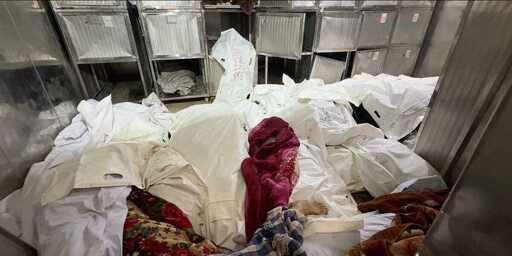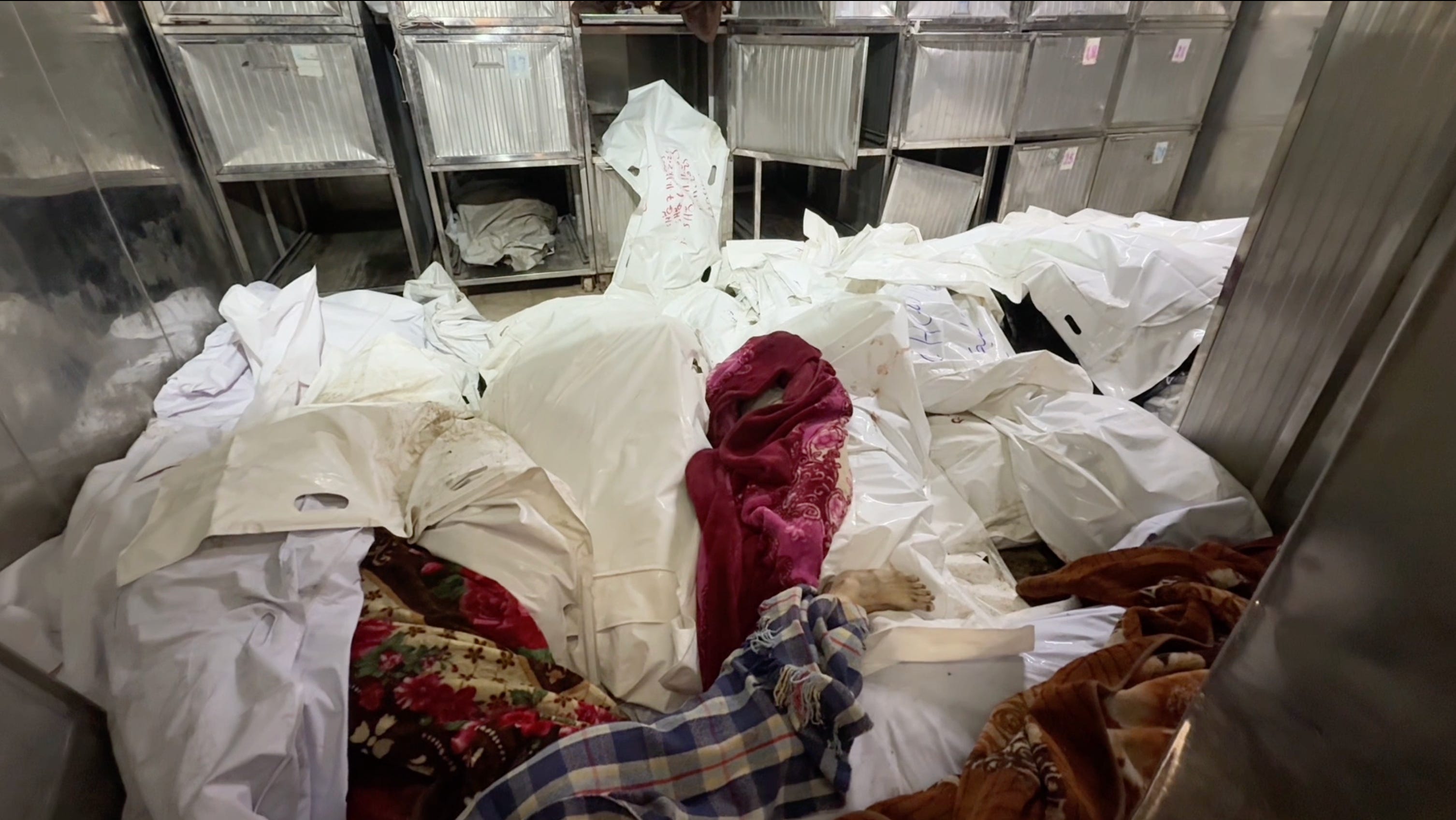We have a commitment to ensuring that our journalism is not locked behind a paywall. But the only way we can sustain this is through the voluntary support of our community of readers. If you are a free subscriber and you support our work, please consider upgrading to a paid subscription or gifting one to a friend or family member. You can also make a 501©(3) tax-deductible donation to support our work. If you do not have the means to support our work financially, you can do your part by sharing our work on social media and by forwarding this email to your network of contacts.
Bodies in the morgue at Al-Shifa hospital in Gaza City on November 20, 2025, following a series of deadly Israeli airstrikes. (Screenshot from video courtesy of Abdel Qader Sabbah.)
GAZA CITY—The Israeli military carried out one of the deadliest attacks on Gaza since the “ceasefire” took effect last month, killing over 30 Palestinians, the majority of them women and children, and wounding dozens more in a series of airstrikes late Wednesday and early Thursday. The dead and wounded arrived at hospitals in an endless stream, children were covered in dust and blood, men carried small bodies wrapped in shrouds, and wails of grief rose in the air
These horrific scenes, a daily feature of the past two years of Israel’s acute genocidal assault, had returned again. “The war has returned to the Gaza Strip,” Mahmoud Bassal, spokesperson for the Civil Defense in Gaza, told Drop Site inside a hospital tent at the Al-Ahli Hospital in Gaza City as the casualties were being brought in. The wounded arrived every few minutes, brought in by ambulances, cars, motorized rickshas—or carried on foot. The dead were wrapped in blankets and sheets.
The dead and wounded arrive at Al-Ahli Hospital in Gaza City on November 19, 2025. (Video courtesy of Abdel Qader Sabbah.)
Most of the casualties came from multiple Israeli airstrikes targeting a tent encampment sheltering the displaced in Khan Younis that killed 17 people, including five children, and from a pair of airstrikes on a building belonging to the Awqaf (Religious Endowments) Ministry sheltering the displaced that killed 16, including seven children, according to hospital officials.
“What is happening in Gaza is something no mind could have imagined,” Bassal said later in the evening as he knelt in front of the bodies of three young children wrapped in one body bag. “It’s madness. These children are being killed—their only crime is that they are children…So to the world, to the nations, to the mediators, to those who oversaw the ceasefire, to those who contributed to stopping the war—now the occupation returns to kill our children—what are you going to do?” He added, “Who will cry for these children? The entire family is gone. The mother died, the children died, the father died—who will cry for them? The world must understand what is happening in Gaza and the gravity of what is taking place.”
Israel claimed without evidence the strikes were in retaliation to Hamas fighters firing at Israeli troops in southern Gaza. At least 33 Palestinians were killed in the Israeli strikes, including 12 children and eight women, according to Gaza’s ministry of health. Hamas dismissed Israel’s claims as an “attempt to justify their ongoing crimes and violations” and condemned what it called a “horrific massacre” and “a dangerous escalation.” It marked the third deadliest attack on Gaza since the ceasefire after a wave of Israeli bombardments on October 28-29 that killed over 100 Palestinians and another on October 19-20 that killed 45.
Bodies of Palestinians killed in Israeli attacks at Al-Shifa Hospital in Gaza City. November 20, 2025. (Video courtesy of Abdel Qader Sabbah.)
The morgue at Al-Shifa hospital on Thursday morning was full of corpses stacked on top of one another wrapped in white body bogs or blankets. Outside, family members wept and embraced their killed relatives one last time before burial.
The Awqaf building in the Zeitoun neighborhood that was targeted was barely standing on Thursday, more a web of broken concrete and rebar than a coherent structure. Cots, mattresses, and blankets were strewn in rooms without walls and cracked columns.
Ishaq Al-Damgha was sitting on the steps of the building when the first of two missiles hit on Wednesday night. “The first missile landed, and the second one fell like a ball of fire onto the place; it set the area ablaze, blew it up, and destroyed everything. It shattered everything and covered the whole area in dust. When the first missile struck, I was sent flying—into the second lane of the street, more than 10 meters away,” Al-Damgha told Drop Site. “We retrieved martyrs—children, men, and women. We retrieved two girls—my cousin’s daughters. After three hours, we retrieved my cousin—three [martyrs]. Then from the Malakah family, a small girl, maybe two years old or younger. We also removed a young man from the Malakah family. From the Azzam family—three children with their mother and father. From the Badwan family…Children and women were the overwhelming number of martyrs.”
The aftermath of Israeli airstrikes on a building belonging to the Awqaf (Religious Endowments) Ministry sheltering displaced Palestinians. November 20, 2025. (Video by Abdel Qader Sabbah.)
On Thursday, Israel moved to expand the area under its control by advancing with a tank incursion in eastern Gaza City and physically moving the yellow concrete blocks that demarcate the “yellow line” to where its troops withdrew last month as part of the ceasefire agreement. The area under its control had already comprised some 58% of the enclave. The blocks were moved an additional 300 meters westward in the neighborhoods of Al-Tuffah and Al-Shujaiya, before the troops pulled back and began shelling the area. Families woke up Thursday to suddenly find themselves on the wrong side of the “yellow line,” causing panic and a new wave of mass displacement.
Hamas spokesperson Hazem Qassem said in a statement that Israel “is committing a blatant violation” by shifting the yellow line westward “resulting in the mass displacement of our people.” Qassem said the changes contravene the maps agreed upon in the ceasefire deal and called on mediators to pressure Israel to immediately cease continued violations.
Yellow blocks moved by the Israeli military in Al-Tuffah neighborhood of Gaza City. November 20, 2025.(Video courtesy of Abdel Qader Sabbah.)
Israel’s attacks came two days after the UN Security Council voted to approve a U.S.-sponsored resolution authorizing an international stabilization force in Gaza, which would not fall under the command of the UN, but rather a so-called Board of Peace chaired by President Donald Trump. The committee would have sweeping authority over Gaza, including overseeing reconstruction, security, economic recovery, and coordinating the distribution of humanitarian aid.
Craig Mokhiber, former director of the New York Office of the UN High Commissioner for Human Rights, blasted the vote. “Not a single member of the Council had the courage, principle, or respect for international law to vote against this US-Israel colonial outrage,” Mokhiber wrote on social media. “This proposal has been rejected by Palestinian civil society and factions, and defenders of human rights and international law everywhere.”
Israel has killed at least 312 Palestinians and wounded 760 since the “ceasefire” went into effect on October 10— leveling entire neighborhoods and destroying more than 1,500 buildings. It has also continued to restrict the amount of aid into Gaza and has not allowed the agreed-upon 600 aid trucks per day into Gaza—what the United Nations has said in the past is the bare minimum amount needed.
Meanwhile, over 17,000 displaced families have been affected by winter storms, according to the UN, with people sleeping in flooded tents without warm clothing. “More than 4,000 households are currently sheltering along the shoreline [in Khan Younis],” the UN said in an update on Wednesday before the Israeli attacks that targeted that very area. “Preliminary findings highlight dire conditions: rising sea levels are encroaching on tents and threaten to submerge the entire area, while strong winds have already caused multiple tent collapses.”
In a statement on Thursday, the Gaza Government Media Office blasted the latest Israeli attacks and its move to seize more territory. “These ongoing crimes represent a clear disregard by the occupation for the ceasefire decision, adding to nearly 400 violations that have been recorded since the decision came into effect,” the office said. “These violations have claimed the lives of more than 300 martyrs, left hundreds wounded, and worsened the catastrophic conditions that our people are experiencing in the limited remaining space of the Gaza Strip.”
Drop Site News Middle East Research Fellow Jawa Ahmad contributed to this report. Sami Vanderlip edited the video.
Correction: This article has been amended to state the Israeli attacks on November 19 and 20 were the third deadliest since the ceasefire took effect, not the second.
From Drop Site News via this RSS feed



